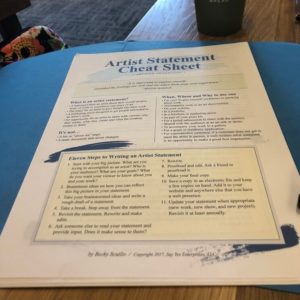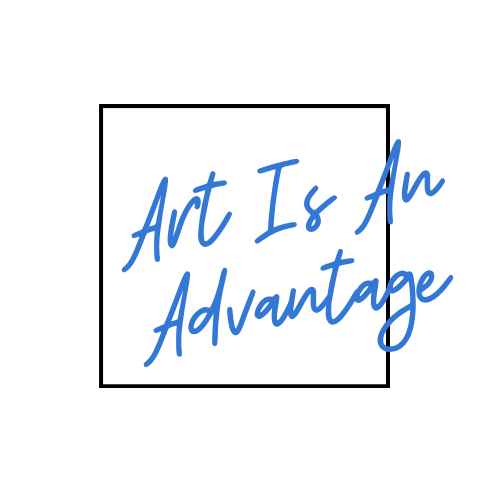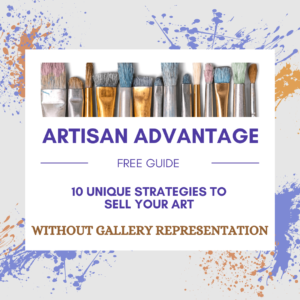by Rebecca Sciullo | Apr 20, 2020 | Artist Blogging 101
Once you understand how your blog is set up and have established your categories, it’s time to start posting. Technically you could upload an image of your work and leave it at that, but a better practice is to put together a well-constructed entry every time you post. This post focuses on how to structure your artist blog posts.
How to Structure Your Blog Posts
Each blog post should contain the following:
Title. Use a strong title that will interest your reader.
Introductory paragraph. Provide a clear introduction prefacing what the post is about with an introductory paragraph.
Headings. In this post, “How to Structure Your Blog Posts” above is a heading. Headings help to capture your audience’s attention. Many readers will quickly skim the headings before deciding whether or not to read more.
Body The body is where you share the bulk of your information. Use shorter paragraphs. Use your authentic voice when you write.
Professional image. Use clear and appropriately cropped images. In addition to your work, incorporate pictures of yourself at work, your studio, or anything else that might be interesting to people who follow your work.
Call to action. At the end, you should ask your reader to take some action. You might ask them to visit your online gallery where you share more images in a collection, sign up for your newsletter, or follow you on Facebook. While you have their attention, make sure you find a way to keep them engaged.
The Importance of Your Writing
For an artist, your work is going to be the focal point of your blog posting, but don’t assume that the accompanying text is not important. Your authentic writing can be a great support to your visual media and should entice your readers to learn more about you and your work. We’ll talk about this more in coming posts.
Stay tuned to Artist Blogging 101 for more tips on writing posts for your artist blog. If you missed earlier posts, start here.
Join the Artisan Advantage newsletter for regular updates.
by Rebecca Sciullo | Apr 6, 2020 | Artist Blogging 101, Learning
How to choose a domain for your blog.
A domain name is what someone types into their internet browser to find your website. My domain name, for instance, is www.artisan-advantage.com.
For an artist, a domain name should be a relatively easy choice. You will likely want your name to be the focus of your domain name.
A domain name might end in .com, .net, .org, or a country code like .us (United States). “URL” or “web address” are other names for a domain.

Register Your Domain Name
When you register a domain name, no one else can register it. Try to keep your domain name simple and easy to remember. If another website is using your preferred domain name, then you won’t be able to use it. In this case, you should come up with an alternative. While .com domains are typically the most preferred domain, but you could see if your name choice is available as .net.
For example, let’s say I wanted to set my domain up as beckysciullo.com, but someone else was using it, I could try a variation such as one of the following:
beckysciulloartist.com
beckysciulloart.com
rebeccasciullo.com
beckysciullo.net
Your domain name is not a “make or break” factor for your site. As long as it is clear that visitors have found your art site, you are doing your job. Give yourself a day or two to think about it, and then make a decision.
For more detail on choosing a domain name, download my free Artist Blog Set-Up Guide.
If you have questions about setting up your domain, drop me a line at becky@artisan-advantage.com.
by Rebecca Sciullo | Jan 8, 2020 | Blogging, Learning
Happy New Year
It’s a new year and a new decade! With all this newness, I’m excited to announce a new focus for Artisan Advantage. Effective immediately, my content will be devoted to teaching artists and creatives how to use blogging to build a visual art business.
Why the change?
As I posted about in My Latest Project, I recently revamped my father’s website and blog. Before starting that project, I felt I needed more focus in my business. I enjoyed sharing information on topics such as creating a vision, constructing an art business plan, planning, time management, pricing, and social media marketing. But the subject matter was too broad, and I was having trouble delivering consistent content. My mind was all over the place.
So with this in the back of my mind, I started the work on my father’s site. Through this work, I decided it was time to focus on building an art business through blogging. It’s an area where I would like to help artists for the following reasons.
1 – I love to blog.
I’ve had experience blogging in a couple of different industries, and I have always enjoyed that work. It was the primary marketing tool that launched my father’s art business in 2007. Blogging is my nerdy passion, and I want to share it.
2 – Most artists overlook the value of blogging in their business.
They either consider it a waste of time, or something they are not equipped or know enough about to do. I firmly believe that both of these things are false and want to help change minds about this.
3 – Blogging is something that every artist can use to further the, no matter the medium, project, or career stage.
4 – Focusing on blogging will help me to deliver more consistent content.
As mentioned earlier, the broad topics of “art marketing” and “visual art business”, I often struggled with what kind of information to provide in my blog posts. This focus will allow me to deliver you consistent, useful content.
So, effective immediately, you will be learning everything I can tell you about how to build a blog and use it for your art business.
What if you don’t want to blog for your art business?
Even if I can’t convince you to blog about your art, you should have a web presence for your art business. I assure you that much information provided will also be useful for any artist with a website.
But what about other art business topics?
You still need knowledge on essential art topics such as licensing work, working with galleries, or selling prints. I will refer you to experts and information that I have found in the course of my business. Look for me to share at least one new resource with you a week in an area outside of blogging. And, the Artisan Advantage Book Club will continue, so stay tuned for reading suggestions and a chance to win a book.
Follow and Share
I hope you will continue to follow my work and share this website with any artists that you think could benefit from my information.
Here’s to a great 2020! Let’s go get it.
by Rebecca Sciullo | Nov 11, 2019 | Artist Websites, Learning, Tools
Are you missing out on timely information?
If you are a subscriber of Artisan Advantage, you should be receiving a newsletter once a month from me.
In talking with a few artists recently that I work with, it seems some of you are not receiving my messages. I’ve also been surprised that winners of my Artisan Advantage Book Club giveaway are not responding to claim their free books! Then it dawned on me that my emails are probably ending up in junk or spam folders.
It is not uncommon for an ISP (Internet Service Provider) to use filters to send an email newsletter to junk or spam folders. It happens to me too. Even my daughter’s school’s emails go to my spam box. And it’s a little embarrassing to not respond to the teacher!
Let’s fix this problem.
by Rebecca Sciullo | Oct 28, 2019 | Learning, Resources, Your Artist Statement
Many artists dread writing an artist statement. They will write a statement when required to do so for an application, a submission, or to accompany an exhibition. While professional artists realize that the artist statement is necessary, and will write one when required to do so, they may not find the process comes easily to them. Also, there are some misconceptions out there when it comes to what an artist statement is.
Let’s review the what and why of an artist statement. I hope to persuade you to write the best one possible for your body of work.
What Is An Artist Statement?
Your artist statement is a written document that explains your intention for your body of work. It helps the reader to understand your work better and could entice them to view it if they have not seen it before.
There are different ideas about what an artist statement should contain and how to write one. A useful statement is one that makes someone want to view your work if they have not done so before. Or, it makes them want to take a second look at your work. It teaches or gives the viewer insight into something they may not know about the work by just looking at it.
Your artist statement is not your bio or about me page. Instead, it is primarily about your work, not your background. Your bio and artist resume/cv should exist separately from your statement.
I encourage you to craft the most effective statement you can for your work at this moment in time.
Why Should You Write an Artist Statement?
The artist statement is more than just a written document about your work. To succeed with your visual art business, you need to stand out, get noticed, and make a connection with people in a noisy world. The artist statement helps you to do that. It is your opportunity to help people to view and understand your artwork, especially when you are not there to speak with them. Also, it forces you to clarify what you want to communicate about your work. By doing this, you will be better prepared to speak and present your work, whether it is in a formal or informal setting.
 The bottom line – an artist statement prepares you for the opportunities that come your way, which is WHY you need to have one that effectively represents your work. Visit the Artisan Advantage Resources page for some tools to help with writing your artist statement.
The bottom line – an artist statement prepares you for the opportunities that come your way, which is WHY you need to have one that effectively represents your work. Visit the Artisan Advantage Resources page for some tools to help with writing your artist statement.
Sign up for the Artisan Advantage Newsletter to get a copy of this Cheat Sheet and more!



